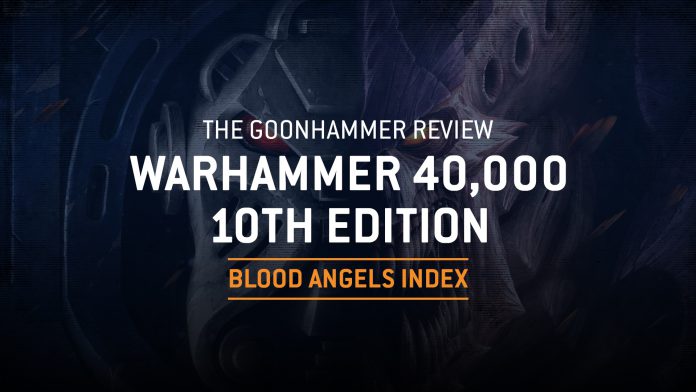The Sons of Sanguinius return in 10th edition form, with their own separate Index to cover their pile of unique datasheets as well as their own Detachment, complete with a set of Enhancements and Stratagems suited for their style of warfare.
Before we begin we’d like to thank Games Workshop for providing us with a review copy of the Index for review purposes.
Faction Rule
In 10th edition, Blood Angels are still Space Marines like any other, and so they don’t have a separate Faction rule – instead they use Oath of Moment like all other (non-Grey Knight) Marines.
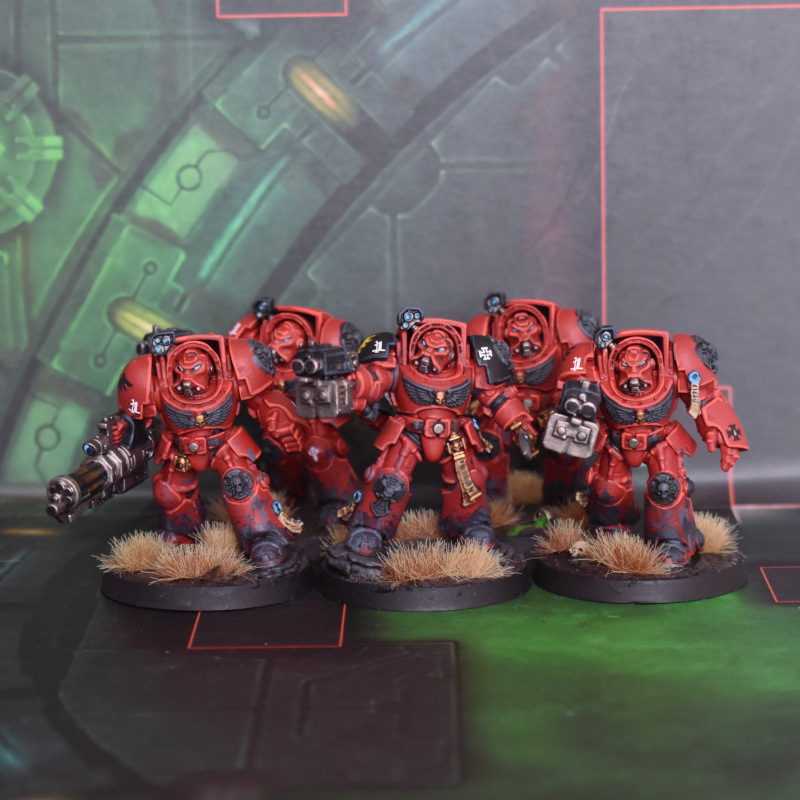
Detachment Rules
The Blood Angels do get a unique detachment of their own, the Sons of Sanguinius. This gives them their own Detachment ability, The Red Thirst, as well as a set of Enhancements and Stratagems unique to this detachment.
It’s worth briefly exploring how these “Chapter-specific” detachments work, because there’s a specific restriction which works similarly for all of them.. The Sons of Sanguinius detachment can include BLOOD ANGELS units – which basically means the ones in this index, who all have this Faction keyword (even Gabriel Seth, who we’ll talk about in more detail later) as well as having ADEPTUS ASTARTES – but you cannot include units from any other Chapter. This is a neat way of doing things; nothing stops you from deciding your White Scars are actually Blood Angels today, and using the Sons of Sanguinius detachment accordingly, because baseline units don’t have any kind of Chapter keyword any more, but you can’t then include Kor’sarro Khan, because he does have WHITE SCARS as a keyword. Equally, as mentioned in the main Space Marines article, you’re perfectly allowed to run your Blood Angels using the Gladius Task Force detachment, and using those rules instead – including taking the unique Blood Angels units and characters – but you don’t get to stack the Detachment ability, Stratagems, or Enhancements, it’s one or the other.
With that slightly wordy explanation out of the way, let’s explore what those Detachment rules are, and why you’d want to use them.
Detachment Ability
The Red Thirst was the Blood Angels’ Chapter trait in prior editions, and now represents the Detachment ability for the Sons of Sanguinius. Compared to its prior incarnation, it’s definitely been toned down – it now gives you +1 Strength and +1 Attack for melee weapons on a turn where you charged. That is much less impactful than the maths-altering power of +1 to Wound rolls, unless your weapons incidentally hit some kind of break point, though it is nice to get more Attacks for units which benefit from some kind of rule like Lethal Hits.
Enhancements
There’s four Enhancements available here, the basic concepts of which will be familiar to players from prior editions, even if the actual mechanical effects have changed. Artisan of War returns, giving one model a 2+ Save and +1 AP on his weapons, while the Archangel’s Shard gives their weapons ANTI-CHAOS 5+ and LANCE. By far the most interesting effects are on the Visage of Death and Icon of the Angel, however; the former halves the Objective Control characteristic of enemy units (excluding Vehicles and Monsters) in Engagement Range of the bearer’s unit, while the latter forces Desperate Escape tests on enemy units trying to Fall Back – and makes these even more dangerous if the enemy is also Battle-shocked.
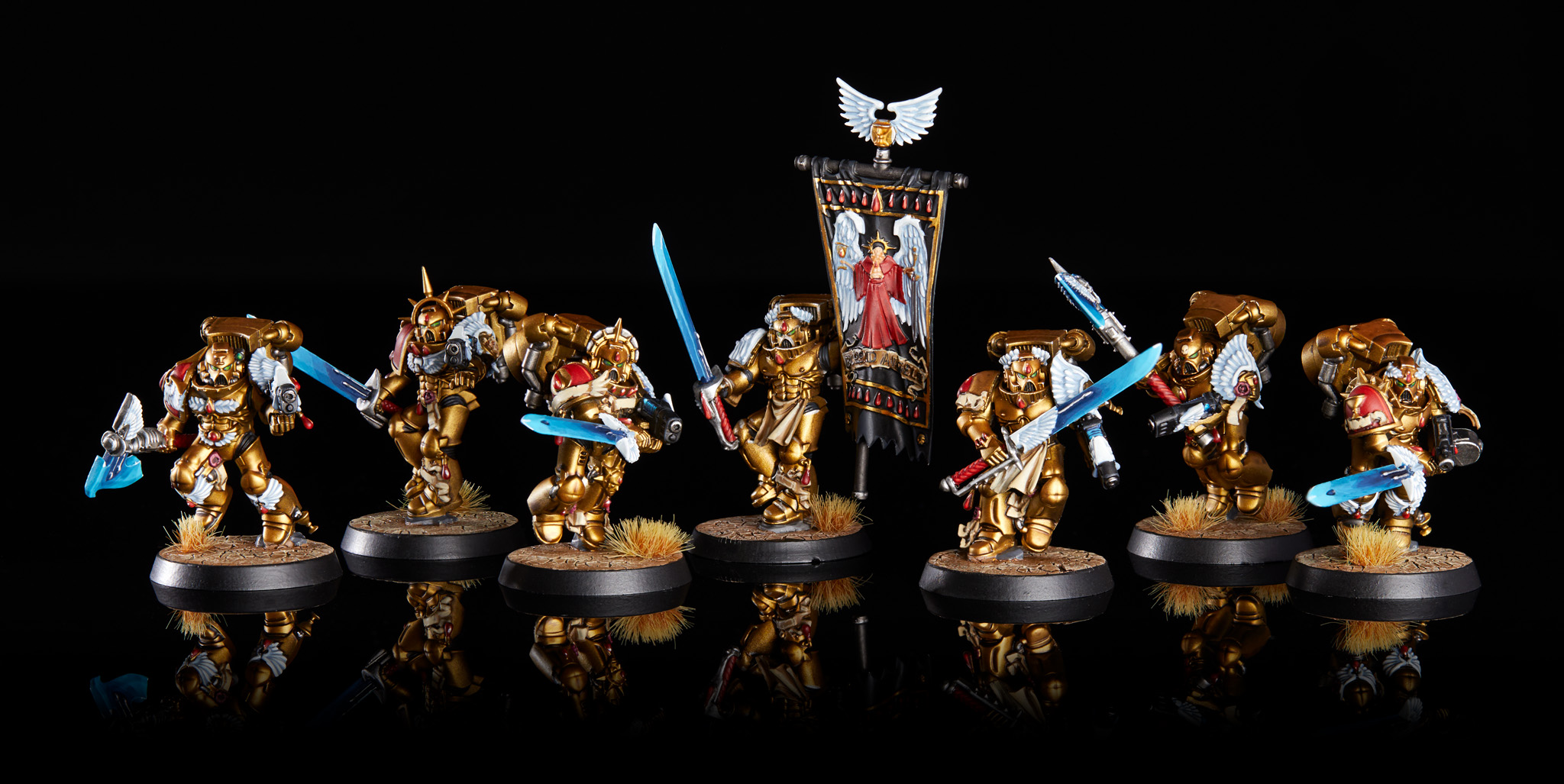
Stratagems
Like all Marine Chapters, the Blood Angels borrow Armour of Contempt from the Gladius Task Force which reduces AP by 1. They also keep Only in Death Does Duty End. The other four are unique to this detachment. Angel’s Sacrifice is usable in any phase; when one of your characters is destroyed, you can spend 1CP and all your units will re-roll Hit rolls against the unit of that destroyed them for the rest of the battle. Aggressive Onslaught boosts your Consolidation range to 6” – though you can’t use this to get in range of an objective, as it must be used to get into Engagement Range. Red Rampage gives a unit both LETHAL HITS and LANCE for a Fight phase, while finally Relentless Assault opens up Fall Back and charge.
Datasheets
Five Coolest Units
- The Sanguinor offers a unique threat
- Commander Dante offers a great package of abilities and lethal combat, especially paired with Sanguinary Guard
- Mephiston brings melee threat, powerful psychic shooting, and a neat combat trick
- Look it’s the characters, ok, that’s what BA brings. Lemartes gives Death Company LETHAL HITS and -1 damage
- Death Company get a great new spin on Black Rage, and pack in the special weapons in volume
Five Biggest changes from 9th
- Sanguinary Guard weapons get reshaped
- The Black Rage is completely changed, granting Hit re-rolls and reducing OC unless a Chaplain is near the unit
- The Librarian Dreadnought is strictly a walker – but also gets some spicy shooting
- Your army is now all about Leaders attaching to give your units a boost – so you’re more likely to see a ‘rainbow’ of different units with their leaders, instead of a mass of similar combat units all clustered around the Icon and an Ancient like 9th
- You no longer get +1 to Wound – a huge downgrade
In substance, a lot of what’s here isn’t that different to what you had in 9th edition. Sanguinary Guard get a neat quality of life change, with axes and swords being compressed back into “encarmine blades” like they were way back in 5th edition. They’re also now down to 1 per 5 for power fists – which is how the kit works, and will be a lot better for anyone buying them new, but is irritating if you already own more with power fists than you can now actually use.
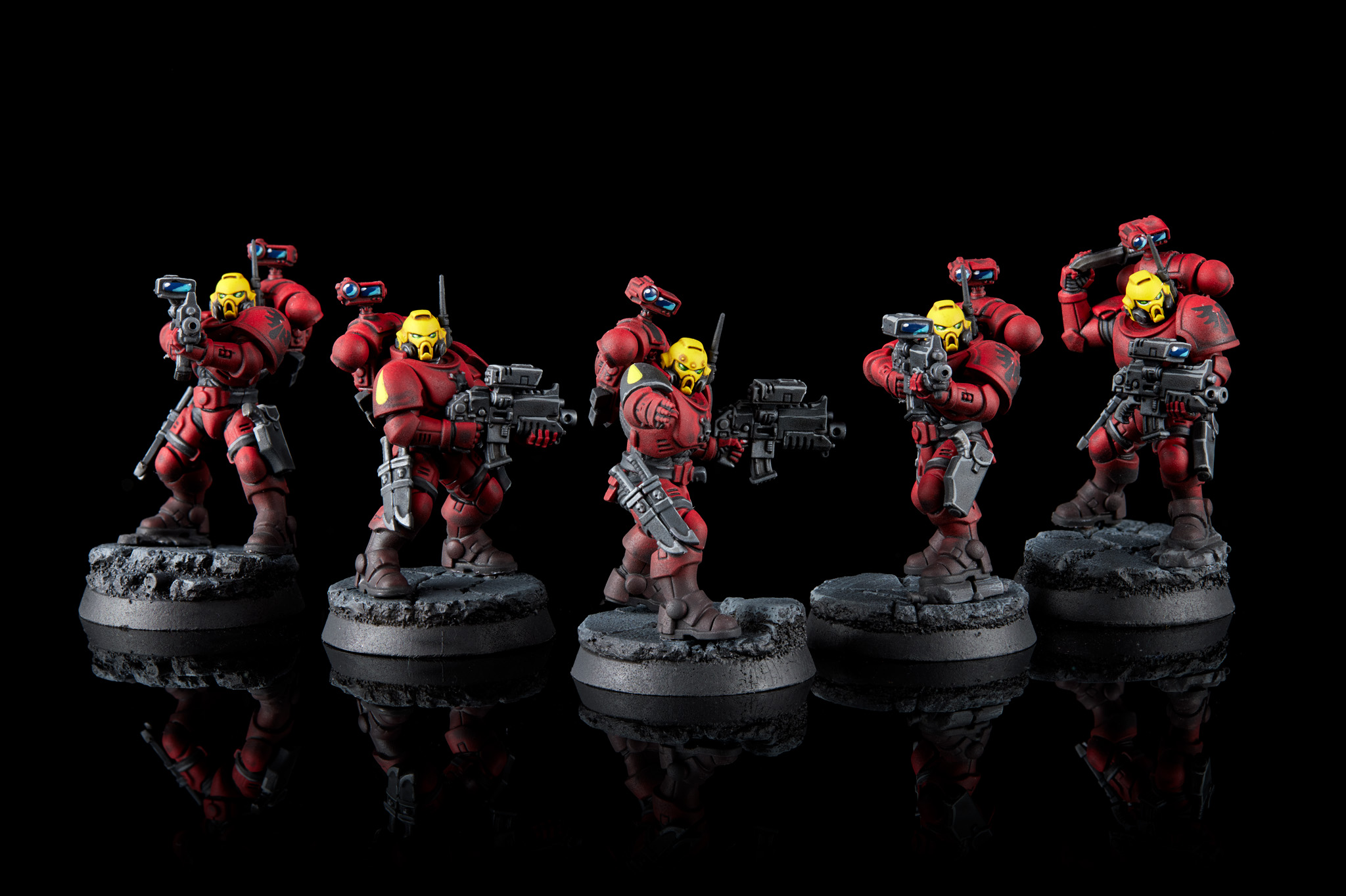
Not reduced is their access to inferno or plasma pistols; you can still outfit these across the entire squad, though inferno pistols are down to d3 damage. Like other similar units, the “Sanguinary Ancient” character from 8th and 9th has been moved back into the unit, and now gives you +1 OC. They keep -1 to hit in melee, but now also get -1 to wound if the Warlord is leading the unit – and you’ll almost certainly want to pair them with Dante, who also gives them +1 to Hit (including with ranged attacks!) and +1 to Charge rolls. Speaking of Dante, as well as decent shooting and great melee, he brings the Death Mask of Sanguinius – which forces a Battle-shock test on every enemy unit within 6” of him, at -1 to the roll, in every Fight phase. This is an innocuous-sounding ability, but its impact can be huge – if your opponent has a Counter-Offensive lined up, or another big impactful Stratagem, or a high-OC unit keeping you from taking an objective for secondaries – Dante can just remove that. Do not forget about this one.
On the Death Company side, the weapon options are all still there – so you can still load up on thunder hammers, or inferno pistols and power weapons, or whatever else. The most significant is the very different abilities for each unit – the jump pack guys, who pair nicely with Lemartes, also get re-roll charges, while the foot version get Sustained Hits 1 if below Starting Strength, or Sustained Hits 2 if they are below Half-Strength. On the Intercessor side, their Visions of Heresy ability allows them to do a free Overwatch or Heroic Intervention once per turn. The Death Company Intercessors might actually get there in 10th, assuming that their points aren’t hugely different to regular ones – you can get strong output from them, they get the 6+ Feel No Pain like other Death Company, and a free Heroic every turn is money in the bank. A Chaplain leading them will give them +1 to Wound in melee, too, replicating some of that 9th edition Blood Angels feel.
The Sanguinor retains his 9th edition rules, with Miraculous Saviour allowing him a once-per-game ability to arrive from reserves straight into combat with an enemy unit which finished a Charge move. The big change for him is that he also has Fights First, so by doing this he not only arrives unexpectedly but he gets to swing before the chargers do – which with 8 attacks at S6 AP-3 D2 and Devastating Wounds, can cause some serious damage. He’s also a Lone Operative, which means he can be hugely powerful if he arrives and clears a weak flank of your opponent’s army – and is then free to run around doing his thing.

Touching back on the list, Mephiston is genuinely psychotic. He gets a slight defensive boost, with a 5+ invulnerable save just in case something with AP-4 looks at him, but his big tricks are The Quickening – now a Fight First ability when he’s leading a unit – and Transfixing Gaze, which on a 2+ reduces enemy WS, and on a 6 reduces WS and Attacks. He can get stuck in with Vitarus in melee, but also if something charges him and survives he can fire both his plasma pistol and also Fury of the Ancients – which on the high-power setting is Hazardous, but gives Sustained Hits 3 on its 3 attacks. He’s a man for all phases, and importantly Fury is great coming out of an Impulsor – perhaps with some Sternguard attached for maximum firepower.
The other characters are all still here, and most are at least passable to good. Sanguinary Priests hand out a chunky 5+ Feel No Pain and improve their unit’s AP with melee weapons by 1 – but they’re held back by being stuck to Firstborn units, without even the option for the flying one to attach to Sanguinary Guard. They can however go with Vanguard Veterans, who will really welcome the AP boost.
The big thing looming over all this is that a big part of your army’s ability to punch up in 9th edition was having +1 to Wound generically on all your units – which meant that any volume of medium-quality attacks had to be taken seriously, and high-quality ones could be exceptionally dangerous to units which might normally be able to tank them, though of course 9th also had an increasing prevalence of Transhuman-type abilities which limited how much this did. That isn’t a thing now, and +1 Strength makes a somewhat poor replacement.
I mentioned earlier that we would return to Gabriel Seth, and how his rules work for representing the Flesh Tearers. His abilities, by the way, are great – built-in Advance and charge, +1 attack for each 5 enemy models within 6”, and 6 baseline attacks with Sustained Hits 1 at S8 AP-2 damage 3. His two big limiters are what he can join – the standard Assault Squad, Command Squad, Tactical Squad and Vanguard Veteran Squad, all on foot. In a simplification from 9th, he now just has the Blood Angels faction keyword – so no need for anything to say “when you read Blood Angels, it means Flesh Tearers” like 9th had – but you cannot include any other BLOOD ANGELS EPIC HERO characters in your army.
Speaking of the odder characters, Captain Tycho survives here in both regular and Death Company forms. Regular Tycho really feels the impact of his worth being decided by what he attaches to – his ability to give out Assault, Heavy, or Rapid Fire each time his unit shoots is very cool, but do you really want or need it on a Tactical Squad? Probably not, especially since he also has Embittered, allowing him to get 12 Attacks with the Dead Man’s Hand as soon as an attack is allocated to him – so if anyone tries to Precision him out of a unit, they don’t even have to wound him to be suddenly facing an infantry-clearing monster.
The Death Company version has an option on living with, well, Death Company, which is more tempting in a world where Land Raiders are good and will allow them to be dumped out into the teeth of the enemy – who needs jump packs? They can also Advance and charge, which is just great; in addition if Tycho the Lost dies he does anywhere up to D6+3 mortals to an enemy unit, getting +2 to the roll to see if the ability works at all if an enemy Warlord is present – making it unfailable, and getting the best result on an effective 4+. Neat stuff.
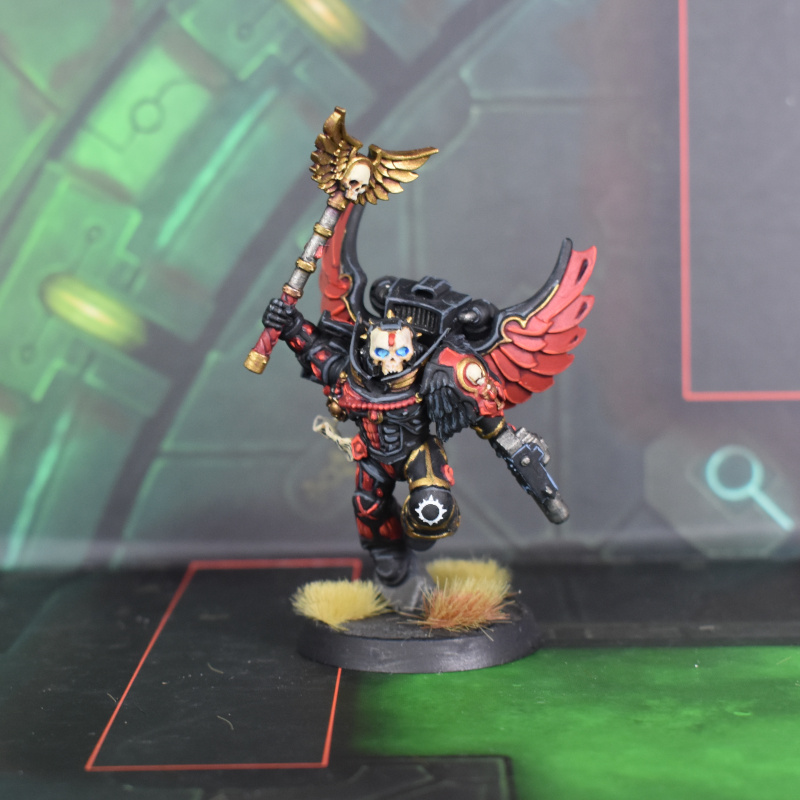
Wrap Up
The Sons of Sanguinius Detachment is a neat little package, and there’s some useful combat boosts in here, but the big question is – do you want these stratagems, and these enhancements, more than you want what’s available in the Gladius Task Force? The answer is probably not. Some of your datasheets are fantastic, but you can use those just as well in the GTF – and the flexibility of what that detachment offers, as well as the huge straightforward boost you get from Assault Doctrine and Adaptive Strategy in particular, plays really well with what those datasheets want to do. Luckily in 10th edition you can just go ahead and run that, but it would be a shame if people didn’t end up using Sons of Sanguinius – it’s just a little hard to see why you would choose to do so.
The other big factor here will be points; a ton of these datasheets look great, but there’s a possibility that they’re very pricey. Mephiston has a huge amount of potential, for example, but he might well end up paying heavily for it; similarly Sanguinary Guard have for free what they used to pay 5pts per model for, and may have been costed as if that’s still true. We’ll have to see how it shakes out, but for now it’s at least looking ok for the Blood Angels in 10th.
